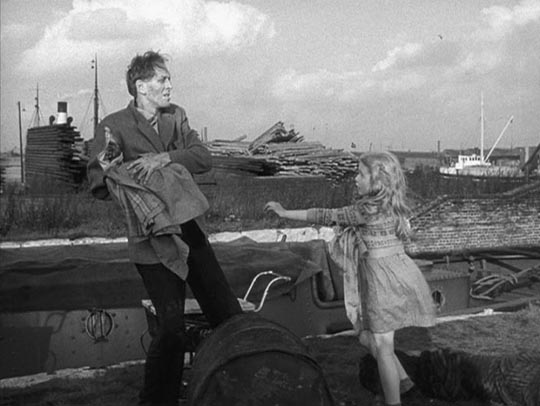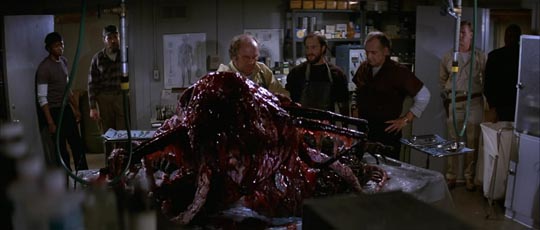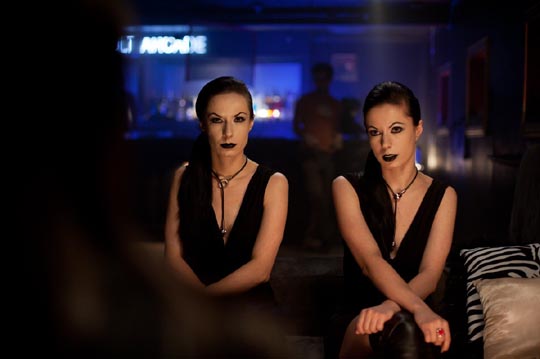Horrors, Old and New

Horror has been a staple of movie-making almost since the medium was invented – Georges Melies made Le Manoir du Diable in 1896 – and the genre has at times been suspended between art and exploitation, though perhaps more often slipping to the latter end of that spectrum. In the silent period, horror was dominated by German Expressionism (The Cabinet of Dr Caligari, Nosferatu, Faust, etc), with a few surrealist intrusions (Jean Epstein’s Fall of the House of Usher). Movies we now consider great expressions of the art made some viewers, critics and commentators uncomfortable, and even Dreyer was thought by more than a few to be wasting his talents on trash with Vampyr (1932). In the ’30s, of course, Universal kick-started a mini-industry in the early days of sound with their Dracula/Frankenstein double whammy, and other Hollywood studios followed suit for a few years until the Production Code put a damper on things – Paramount’s Island of Lost Souls, MGM’s Freaks, Mad Love, The Devil Doll … but under the influence of the code, by the end of the decade and into the early years of the war, the genre had devolved to kid-friendly fare like Universal’s House of … mash-ups, culminating in Abbott & Costello Meet Frankenstein in 1948.

In the ’50s, the genre definitely sank into the often entertaining swamp of teen exploitation until Britain’s Hammer Films gave it a stronger, more mature direction when they followed their sci-fi/horror hit The Quatermass Xperiment with a revival of Dracula and Frankenstein, revisiting Universal’s strategy in garish Technicolor, with more overt erotic emphasis and, for the time, surprisingly graphic gore. While Hitchcock shocked the movie establishment – and raked in the bucks – with Psycho (1960), and Michael Powell’s career was all-but-sunk by disgusted critical response to his brilliant Peeping Tom that same year, their example was only sporadically followed until the ’70s when “body count” horror really took off (The Texas Chainsaw Massacre, Black Christmas, Halloween), while classier, more classically-oriented films like Jack Clayton’s The Innocents and Robert Wise’s The Haunting kept the supernatural side alive.

With the loosening of censorship in the later ’60s, horror found it increasingly unnecessary to be subtle; filmmakers were able to start spraying the screen with blood and body parts, but by the height of the splatter era in the ’80s, it had already started to become a bit of a bore. There was nowhere left to go but into greater extremes – a trend which finally saw full flower in the torture porn exemplified by the Saw and Hostel franchises and their imitators. But even in the face of apparent demand for little more than graphic dismemberment, some filmmakers took a more traditional approach, building atmosphere, occasionally even paying attention to character and thematic content. The erratic John Carpenter tackled old-school ghosts in The Fog and possibly the finest alien threat ever in The Thing, while in 1981 John Landis and Joe Dante revived the werewolf in a pair of films which harked back to classic Universal horrors in their use of comedy to heighten the scares, while simultaneously looking forward to a brave new world of seemingly unlimited special effects possibilities.
The Howling (Joe Dante, 1981)

I haven’t seen Landis’s An American Werewolf in London in years and truth is I never liked it as much as Dante’s The Howling, though on a technical level Rick Baker’s transformations were perhaps more accomplished than Rob Bottin’s (Bottin would outdo both himself and Baker the next year in The Thing, work which has never been bettered even with the advent of CGI). I just revisited The Howling after probably more than a decade, watching Shout! Factory’s new Blu-ray edition. Visually, the film is very much of its time, both in terms of the fashions worn by the characters and the bright neon colours of the photography. It also has a witty, occasionally satirical script co-written by John Sayles, which can’t help but inspire nostalgia for the day when genuine writers worked on seemingly disposable exploitation scripts.

While Bottin’s effects don’t seem quite so impressive 30+ years on (he rather over-did the bladder effects in the big set-piece transformation), the well-drawn characters and the amusing conceit of a self-help community of werewolves supporting each other through their socially awkward physical problems keep the movie fresh. And as an added bonus, it boasts one of Dick Miller’s greatest bit parts as the cynical owner of an occult bookstore (on the need for silver to dispose of werewolves: “They’re tough to kill, worse than cockroaches”).
Lifeforce (Tobe Hooper, 1985)

Made just three years later, and taking a bigger risk in terms of tone, Tobe Hooper’s Lifeforce has always faced a rough time from both fans and critics. By the time this adaptation of Colin Wilson’s novel Space Vampires came out, people were fully acclimatized to the prevalent comic tone of horror exemplified by Dante and Landis as well as the obsessively detailed realism represented by Ridley Scott’s Alien and Blade Runner; many found Lifeforce hard to “read”, a problem compounded by the adolescent snickering provoked by the completely unselfconscious nudity of Mathilda May in the first act.

I’ve always had a real fondness for Lifeforce – and not just because I actually got to visit the set in London in 1984, shown around by John Dykstra whom I’d met the previous year while working on David Lynch’s Dune. I toured the basement lab set with its layered glass perspectives, and also saw the very large model of the alien ship, which was an impressively detailed miniature maybe twenty or more feet long. Perhaps that visit (and the fact that I’d been a long-time fan of Wilson’s writing, though not of that particular book) predisposed me to like the movie. But equally important, I think, was its determination to treat the story completely seriously and, having been made in England, to harken back to the work of Nigel Kneale, particularly Quatermass and the Pit (filmed for Hammer by Roy Ward Baker in 1967, one of the last great pre-2001 sci-fi movies). Lifeforce even shares some thematic elements with Kneale’s work, the idea that we’ve been shaped by alien interventions in the distant past and that our myths and legends are actually distorted memories of those long-ago encounters.

Hooper and his cast tear into the material with complete conviction – Steve Railsback as the psychologically tormented Carlsen, unwillingly linked by psychic bonds to the alien; Peter Firth as the terse SAS officer; Frank Finlay as the helpful brilliant scientist who figures out just what’s going on; and the quite stunning May, a French dancer just breaking into acting, who embodies that core idea of the genre that sex, danger and death are all inextricably intertwined. The intensity of the performances often triggers audience laughter because without the built-in comic relief of movies like The Howling, viewers tend to be made uncomfortable – after all, are the filmmakers really expecting us to take this stuff seriously? Personally, I find that expectation refreshing, the idea that Hooper, his cast and technicians, and scriptwriters Dan O’Bannon and Don Jakoby, don’t hedge. Obviously for a lot of people the risk didn’t pay off, and even fans of the film tend to see it as whacky and deranged; I prefer to accept it on its own terms and immerse myself in its mythic/apocalyptic conviction.
Viewed again on the new Shout! Factory Blu-ray, I enjoyed it as much as I did that first time in a theatre in 1985. It has a kind of retro look, a throwback to the ’60s which clearly influenced it, while the effects of Dykstra and his crew have a majestic sense of scale. I’ll go out on a limb and say that, in Hooper’s undeniably uneven career, Lifeforce is his crowning achievement.

Both The Howling and Lifeforce are clearly from another time – in many ways, despite the end of the Production Code, still a more innocent time than we live in today. We’ve seen so much in the intervening years that it takes a lot to disturb us now. Kids go to movies like Saw and Hostel to laugh at the increasingly sadistic violence. In fact, the audience’s sophistication about effects makes it almost impossible to genuinely disturb anyone with the graphic display of bodily trauma. Perhaps this is one of the main reasons for the continuing success of movies like Paranormal Activity, The Last Exorcism, The Conjuring … these films have rediscovered what Val Lewton asserted so forcefully back in the ’40s: that suggestion and the unseen are often more terrifying than a full-on monster. The trick is to work past the cortex and down into the amygdala, to bypass our conscious responses and trigger our primal reaction to threats (the more uncertain the threat, the more intense the reaction).
In other words, horror is more effective when it goes deeper than a simple visceral response to gross visuals. A couple of recent films which operate on this level with varying degrees of success are the Soska twins’ American Mary and Brandon Cronenberg’s Antiviral, both released in 2012 and both, perhaps not coincidentally, Canadian.
American Mary (Jen and Sylvia Soska, 2012)

Jen and Sylvia Soska, with only one previous feature (Dead Hooker in a Trunk [2009]) and some shorts to their credit, have come up with a comically transgressive idea in American Mary (not sure just what the title is supposed to mean): promising med student Mary (Katherine Isabelle of Ginger Snaps fame, excellent here) has serious money problems and is facing expulsion from school. Pure chance puts her in a position to profit from her training when a seedy club owner gives her a wad of cash to fix up one of his badly injured crew. Word starts to get around and Mary discovers that she maybe doesn’t need to graduate after all – she becomes a star in the underground body-mod scene, surgically altering people who pay big money to be transformed.

But it’s not just about the money. Having been drugged and raped at a party by her favourite teacher, she uses her skills to wreak revenge. But the more her underground fame spreads, the closer the police get in investigating the teacher’s disappearance … The movie is strongest in its depiction of Mary’s increasing confidence and the complexity of her work (some of the supporting cast appear to be genuinely “modified” people); the Soska twins appear as a pair of German fetishists who want to be worked on jointly, in a sequence which marks the peak of the film’s fetishistic revelry. But strangely, from there on it loses imaginative steam and heads directly towards a surprisingly conservative, decidedly non-transgressive ending, its unsettling glimpse of an extreme sub-culture swept away in a “wages of sin” climax.
Antiviral (Brandon Cronenberg, 2012)

There’s a touch of Cronenbergian body-horror in American Mary, something which not surprisingly comes to full bloom in Antiviral, the accomplished first feature of David’s son Brandon. It’s tempting to speculate what growing up with Cronenberg as your dad might do to you psychologically, and it’s clear that Brandon has absorbed a lot of his father’s ideas. Predicated on an up-to-the-minute consideration of the nature of contemporary celebrity worship, Antiviral also harkens back to David Cronenberg’s own early work: the pristine institutional settings of the first experimental features (Stereo [1969] and Crimes of the Future [1970]) and the visceral body horror of Crimes and the early commercial features (Shivers [1975], Rabid [1977], The Brood [1979]), with more than a touch of The Fly (1986).

In Antiviral, corporations have discovered a way to monetize fan obsession; they harvest diseases from the famous and sell them as designer infections to the fans, allowing them to enter into a kind of molecular communion with their idols. Syd March (Caleb Landry Jones, who bears a striking resemblance to Ron Mlodzic, star of Stereo and Crimes of the Future) is a salesman and “harvester” for one of these corporations and he happens to have just obtained a virus from Hannah Geist (Sarah Gadon), a much-loved celebrity who appears to be famous for nothing more than being famous, who has now died. This final infection is the grail for virus-dealers and, against all the rules, Syd infects himself with it, becoming pursued by various agents who will go to any lengths to get their hands on it.

Visually precise, with interesting performances, Antiviral follows its ideas to their logical end, with pop culture a disease we all willingly become infected by. In one of the film’s creepier sub-themes, restaurants sell meat grown from stem cells harvested from the famous, reinforcing the idea that fans desire the most intimate communion (beyond the superficial idea of sex) with the people they worship.
Like his father before him, Brandon Cronenberg has an obvious knack for combining queasy physical horror with even more disturbing conceptual horror. Antiviral confidently continues a family tradition which has left a distinctive mark on Canadian film over the past four decades.
Comments
Great post. Passing it on as a “must watch” list to a couple of people.
SteveG
And on John Carpenter’s “The Thing”. I watched it again recently, right after the recent prequel, also called “The Thing”. Two things struck me. One, the effects in the Carpenter version are tougher to watch. The lack of CG makes the characters appear to be right there, the horror of that monster right in their faces (and ours), while the monster in the remake, despite the sophistication and detail of the effects, elicits merely a yawn. Who cares? It doesn’t seem real. And because it doesn’t feel real, you don’t get the feeling that the characters are right there in the middle of it. CG has made horror films of this type quite disappointing. Two, Carpenter manages to truly capture the brutal cold and remoteness of the Antarctic setting. It looks cold. The characters look cold. At the end, there’s no doubt about what’s going to kill both remaining characters. In the remake, it looks like it’s supposed to be cold… but never really gets there.
It looks cold because they actually shot in real snow (in northern BC and Alaska). And I totally agree: CG, no matter how slick, can never really equal well done physical effects shot on stage with the actors.
Lifeforce was audacious in so many ways. A visual assault on the senses for the time in which is was released. Like the scene where the reanimated male victim entices the surgeon to come to him with grunts and groans and gives not the kiss of life but the kiss of death. He stands there innocently happy to be alive and you’re thinking, “…what did I just see?”